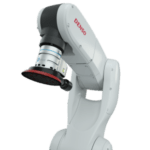OnRobot launches out-of-the-box robotic sanding tool
OnRobot has launched OnRobot Sander, an all-electric random orbital sander for automated finishing applications, including sanding and polishing. Traditional sanding automation solutions often require a background in robotics to implement and maintain. With the launch of OnRobot Sander, manufacturers now have access to a complete out-of-the-box sanding tool that’s easy to use with all major collaborative and lightweight industrial robots. The complete Sander package incorporates everything OnRobot customers need to get their sanding application started quickly and easily: a plug-and-play sanding tool, a variety of standard sanding and polishing pads, easy-to-use programming software, an optional force/ torque sensor and a Grit Changer that enables automated switching between different sanding grits without operator intervention. Taking usability a step further Programming simple surface finishing applications on Sander is easy thanks to the intuitive built-in software. But OnRobot takes usability a step further with the addition of a “Save Position” button on the tool that allows users to set waypoints manually without using the robot’s teach pendant. The Sander software comes with different path planning options – handguide, shape and points, and allows users to adjust rotation speed, optimising cycle time and consistency. “OnRobot is committed to providing small and medium-size businesses with affordable, application-centered solutions that are easy to set up and maintain. OnRobot Sander is a versatile sanding tool that provides all the features and benefits our customers expect of automated sanding technology, but without all the hassle and cost traditionally associated with automated sanding tools,” says Enrico Krog Iversen, CEO of OnRobot. OnRobot Sander supports flat, curved and uneven part geometries and comes with replaceable standard pads that can be used on a wide range of materials. Adding a force / torque sensor enables the sander to adapt to surface variations or part misalignment, while improving consistency and quality and […]










